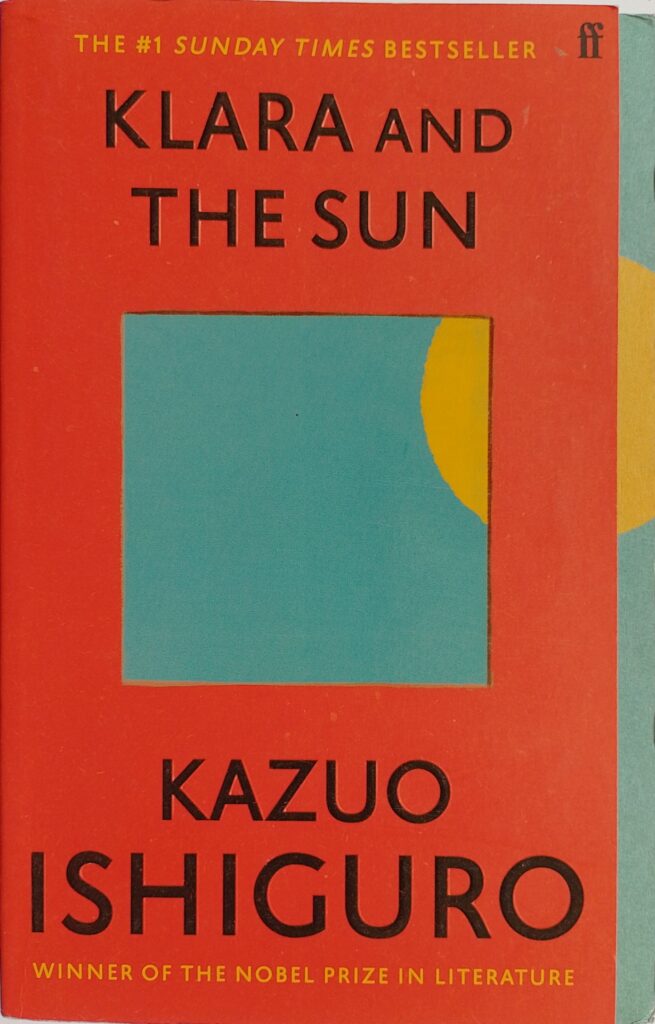First published 2021. Faber paperback, 2022, pp 340, c.90,000 words.
Ishiguro’s familiar compass, buttoned up and drained of soul, is well suited to the near-future world he creates here. The protagonist, Klara, is programmed to selflessness, as it can also be said of Stevens in The Remains of the Day, Kathy in Never Let Me Go, and many other Ishiguro characters. Amongst the dryness is charm, and underlying the story is bitter-sweetness. The book has beautifully crafted prose, with very subtle, and unbalancing, changes of tone.
The setting is the United States, and the time is the near-ish future, although a few elements appear to have regressed to anything between the 1940s and the present. Some of the technologies are much further advanced than any known today. Parents have to decide how much risky intervention they should put their children through to enable them to compete successfully – a ghastly Russian-roulette, only slightly less horrifying than that in Never Let Me Go. There is much use of ‘oblongs’ for information, communication and teaching. Artificial intelligence is substituting for humans at work and for education. Home-schooled children have to be forced into social interactions. Those rendered unemployed may be lured into fascist groups. This is a plausible dystopia, with an underlying current of forces having been unleashed that cannot be controlled or even understood. Without that understanding, how can we be certain that the decisions the machines are making are in humanity’s interest or even rational, and not based on some cock-eyed view of the world arrived at by random experience as is displayed here?
Klara is intended to become a teenager’s friend. She is said to be particularly observant, and we are given her thoughts as she experiences and tries to interpret, and sometimes misinterprets, the world around her. From the beginning, Klara is warned not to invest too much in promises. Ishiguro presents a bleak view of human relationships as being impermanent; none of the families presented here have a feeling of durability. Characters pledge loyalty, but then drift apart. Sometimes the relationships dissolving in anger and tears and sometimes just for want of sustenance, having run their natural course.
The construction of Klara’s view of the world is brilliantly handled, with early experiences informing later ones, however perversely. For example, when Klara arrives in the countryside, having only previously experienced the hustle and bustle of a big city, she observes: ‘The grass was tall in all three fields, and when the wind blew, it would move as if invisible passers-by were hurrying through it.’ [p61]. What a simple, elegant and information-laden sentence that is, so typical of Ishiguro’s work.
There are a couple of characters whose descriptions are dangerously close to being racist; in this respect, future America has not moved on from the 1950s. The housekeeper is given a ‘mammy’ speech-pattern, and the manager of the diner is described as being ‘a large black-skinned man’ [p272]. There didn’t seem to be any plot-driven reasons for these choices. What has changed here from 1950s America is the role of women in society: they seem to have equal opportunities to the men.
The past is also evoked in the description of that city diner where some of the characters meet up. It immediately brought to mind Edwin Hopper’s 1942 painting Nighthawks. Similarly, Andrew Wyeth’s 1948 painting Christina’s World, with its teenage girl in a field and endless, but oh-so-constricting, horizons is also brought to mind by the teenage Josie’s prairie home. The inspiring subject of that picture was in real life disabled, as it might be said in different ways of both Klara and Josie. The capturing of these iconic images in subtle prose is very well done, packing a disconcerting resonance.
There are occasional delicate shifts in speech-patterns and behaviours that undermine our grip on the story. ‘I saw Josie, waving with a puzzled expression from the crowd’s edge, and the Mother, standing behind her, a hand on each of Josie’s shoulders, watching us with empty eyes.’ [p271]. No explanation is given for either the mother’s or the daughter’s expressions. Maybe a failure in Klara’s understanding is intended.
Ultimately this is a tragedy, albeit a very gentle one. It is a warning against wandering blindly into some techno-future, where responsibility is fast being handed over to machines without us noticing or understanding quite what is happening.
This book has much wit and good-will, particularly in the character of Klara. The writing is beautifully crafted and elegant. It beguiles with its naivety, and yet its veiled message is potent. It is a worthy addition to Ishiguro’s body of work.
Wikipedia biography of Ishiguro: https://en.wikipedia.org/wiki/Kazuo_Ishiguro
Wikipedia summary of the book: https://en.wikipedia.org/wiki/Klara_and_the_Sun
Others’ reviews of the book: https://www.goodreads.com/book/show/54120408-klara-and-the-sun?from_search=true&from_srp=true&qid=qHHLYB06Pq&rank=1
© William John Graham, June 2023

